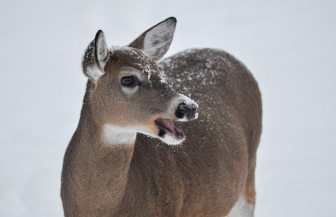By Elinor Epperson

A white-tailed deer on a snowy November day in Marquette County. Image: Michigan DNR
Researchers at Cornell University are studying whether machine learning can help states and tribes predict the spread of a dangerous disease plaguing North American deer.
A recent study done in partnership with Michigan State University showed that machine learning could calculate where chronic wasting disease will spread at the county level. That information will help state and tribal agencies address a problem much larger than their individual jurisdictions, said Mitch Marcus, the wildlife health supervisor at the state Department of Natural Resources.
“Wildlife and associated disease and or wildlife pathogens don’t understand or know jurisdictional boundaries,” he said.
Chronic wasting disease is a neurological, degenerative disease caused by prions. Prions are misfolded proteins that cause brain damage.
The pathogen is extremely persistent in the environment and can spread between deer through saliva, blood and waste. It first appeared in wild deer in Michigan in 2015. It has since spread to 13 counties.
Once a deer contracts the disease, it can take 18 to 24 months to die. That’s ample time to spread the pathogen to other deer – and for them to meander in front of your car.
It can infect moose and elk as well, although there are no known cases involving those species in Michigan, Marcus said.
Chronic wasting disease has no known cure, so prevention is key, experts say. But because the disease has spread across 35 states and four provinces, tracking it is difficult.
That’s where machine learning can help, said Krysten Schuler, a co-author of the paper.
“The system is capable of running thousands of calculations that would take us normally a very long time,” she said. Schuler is a wildlife disease ecologist and director of the Cornell Wildlife Health Lab. She has testified before Congress about the threat chronic wasting disease poses to cervids and people.
The research comes from a coalition of states, provinces and tribal governments called the Surveillance Optimization Project for Chronic Wasting Disease. Michigan is a participant.
Schuler and her colleagues used data from 16 states and provinces to help four AI models predict where the disease would spread next. They compared the results from those models to actual testing results from the 2020-21 hunting season.
“We’re really interested in how surveillance can detect the disease at its earliest incursion,” Schuler said. By looking at several different factors — habitat, regulations, and deer population, for example — researchers can determine where the disease is more likely to spread.
Each model determined that different factors influenced the disease’s spread the most. One model was more aligned with real-life results than the others. But there is still not enough data to definitively confirm which model is best, according to the study.
The project will continue this research by collecting more data from participating agencies, Schuler said.
In the meantime, the DNR will be tracking deer in 22 counties to collect baseline data. Hunters can bring deer to staffed check stations in these counties for free testing.
Test kits are also an option throughout the state, but may cost money depending on where a hunter is.
Submitting specimens for testing provides the department with valuable information about the state’s deer population. Although that population is booming, the disease could cause it to crash, Schuler said.
Schuler said the presence of CWD discourages hunting in a state where the sport is already declining for other reasons.
Marcus said the disease can indirectly affect residents who don’t hunt as well.
“Michiganders value natural resources and wildlife,” he said. “And most people don’t like to see sick animals.”
Schuler encourages members of the public to help prevent the disease’s spread. For hunters, that means following regulations like baiting bans. She said everyone should keep their eyes peeled for ailing deer.
“This is one of the situations where hunters and the public actually have the ability to influence the disease progression by their actions,” she said.
Elinor Epperson has an environmental reporting internship under the MSU Knight Center for Environmental Journalism’s diversity reporting partnership with the Mott News Collaborative. This story was produced for Michigan Public.